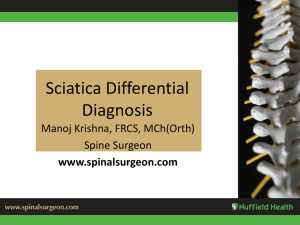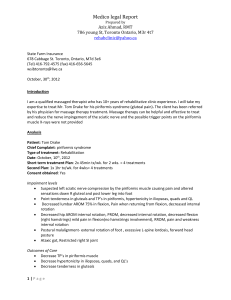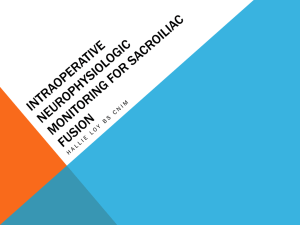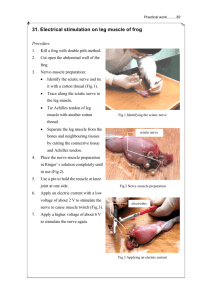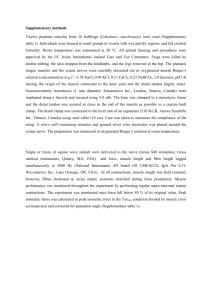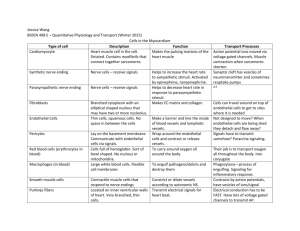H. LOCAL SYNDROMES OF THE LOWER LIMBS GROUP XXXI
advertisement
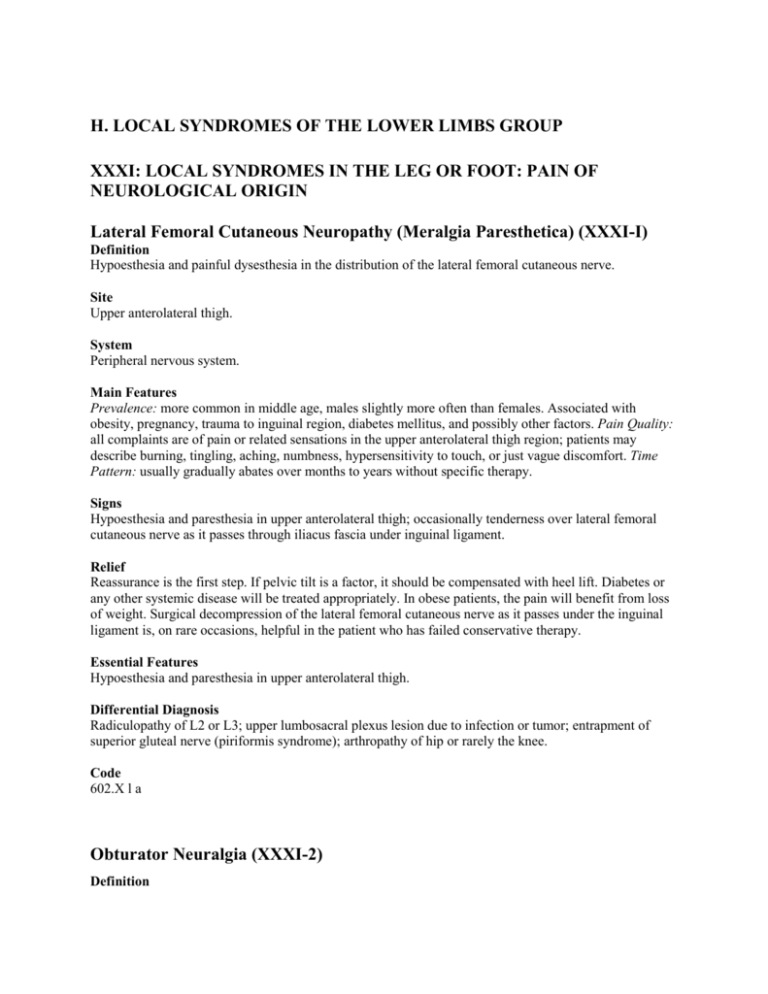
H. LOCAL SYNDROMES OF THE LOWER LIMBS GROUP XXXI: LOCAL SYNDROMES IN THE LEG OR FOOT: PAIN OF NEUROLOGICAL ORIGIN Lateral Femoral Cutaneous Neuropathy (Meralgia Paresthetica) (XXXI-I) Definition Hypoesthesia and painful dysesthesia in the distribution of the lateral femoral cutaneous nerve. Site Upper anterolateral thigh. System Peripheral nervous system. Main Features Prevalence: more common in middle age, males slightly more often than females. Associated with obesity, pregnancy, trauma to inguinal region, diabetes mellitus, and possibly other factors. Pain Quality: all complaints are of pain or related sensations in the upper anterolateral thigh region; patients may describe burning, tingling, aching, numbness, hypersensitivity to touch, or just vague discomfort. Time Pattern: usually gradually abates over months to years without specific therapy. Signs Hypoesthesia and paresthesia in upper anterolateral thigh; occasionally tenderness over lateral femoral cutaneous nerve as it passes through iliacus fascia under inguinal ligament. Relief Reassurance is the first step. If pelvic tilt is a factor, it should be compensated with heel lift. Diabetes or any other systemic disease will be treated appropriately. In obese patients, the pain will benefit from loss of weight. Surgical decompression of the lateral femoral cutaneous nerve as it passes under the inguinal ligament is, on rare occasions, helpful in the patient who has failed conservative therapy. Essential Features Hypoesthesia and paresthesia in upper anterolateral thigh. Differential Diagnosis Radiculopathy of L2 or L3; upper lumbosacral plexus lesion due to infection or tumor; entrapment of superior gluteal nerve (piriformis syndrome); arthropathy of hip or rarely the knee. Code 602.X l a Obturator Neuralgia (XXXI-2) Definition Pain in the distribution of the obturator nerve. Site Groin and medial thigh as far distal as the knee; usually unilateral. System Peripheral nervous system. Main Features Constant pain in the groin and medial thigh; there may be sensory loss in medial thigh and weakness in thigh adductor muscles. Indefinite persistence if cause not treated. Associated Symptoms If secondary to obturator hernia, pain is increased by an increase in intra-abdominal pressure. If secondary to osteitis pubis, pain is increased by walking or hip motions. May be tender in region of obturator canal. Signs Hypoesthesia of medial thigh region, weakness and atrophy in adductor muscles. Laboratory Findings If the neuropathy is severe, there may be EMG evidence of denervation in the adductor muscles of the thigh. Usual Course Constant aching pain that persists unless the cause is treated successfully. Complications Progressive loss of sensory and motor functions in obturator nerve. Social and Physical Disability When severe, may impede ambulation and physical activity involving hip. Pathology Obturator hernia; osteitis pubis, often secondary to lower urinary tract infection or surgery; lateral pelvic neoplasm encroaching on nerve. Essential Features Pain in groin and medial thigh; with time the development of sensory and motor changes in obturator nerve distribution. Differential Diagnosis Tumor or inflammation involving L2-L4 roots, psoas muscle, pelvic side wall. Hip arthropathy. Code 602.X6a 602.X l b 602.X2a 602.X4a Obturator hernia Surgery Inflammation Neoplasm Femoral Neuralgia (XXXI-3) Definition Pain in the distribution of the femoral nerve. Site Anterior surface of thigh, anteromedial surface of leg, medial aspect of foot to base of first toe. System Peripheral nervous system. Main Features Constant aching pain in anterior thigh, knee, medial leg, and foot. The pain may involve only a portion of the sensory field due to pathology in only one branch of the nerve. There may be sensory loss in similar areas and weakness of the quadriceps femoris, sartorius, and associated hip flexor muscles. Associated Symptoms If the disorder is secondary to femoral hernia, pain is increased by increase in intra-abdominal pressure. Trauma to the saphenous nerve may result in an isolated sensory deficit in the knee or leg with local pain. Signs Hypoesthesia in anterior thigh, medial leg, and foot or portion thereof; weakness and atrophy in sartorius or quadriceps femoris muscles if lesion proximal to upper thigh. There may be local tenderness at the site of nerve injury. Laboratory Findings If the neuropathy is severe, there may be EMG evidence of denervation in sartorius and quadriceps femoris muscles. Usual Course Constant aching pain which persists unless cause is successfully treated. Complications Progressive sensory and motor loss in femoral nerve or its branches depending upon site of lesion. Social and Physical Disability Major gait disturbance if quadriceps femoris is paretic. Pathology Trauma to femoral nerve or its branches; femoral hernia. Essential Features Pain, weakness, and sensory loss in the distribution of the femoral nerve or its branches. Differential Diagnosis Neoplasm or infection impinging upon femoral nerve, L2-L4 roots, psoas muscle, or pelvic sidewall. Hip or knee arthropathy. Code 602.X2b 602.X4b 602.X6b Inflammation Neoplasm Arthropathy Sciatica Neuralgia (XXXI-4) Definition Pain in the distribution of the sciatic nerve due to pathology of the nerve itself. Site Lower extremity; may vary from gluteal crease to toes depending upon level of nerve injury. System Peripheral nervous system. Main Features Continuous or lancinating pain or both, referred to the region innervated by the damaged portion of the nerve; exacerbated by manipulation or palpation of the involved segment of the sciatic nerve. Associated Symptoms Weakness and sensory loss in muscles and other tissues innervated by the damaged portion of the nerve; secondary changes due to denervation if there is major injury to the nerve. Signs Sensory loss; weakness, atrophy, and reduced reflexes in denervated muscles. Laboratory Findings Electromyographic and nerve conduction studies document nerve damage; roentgenograms or CT scans may reveal lesion causing nerve damage. Usual Course If a progressing lesion is the cause of the pain, the patient will have an increasing neurological deficit and pain may decrease. If a static intraneural lesion is the cause of the pain, the neurological deficit is fixed and pain is likely to persist indefinitely. Relief Remove offending lesion impinging upon nerve. Complications Progressive neurological deficit in the territory of the involved nerve. Social and Physical Disability Severe pain can preclude normal daily activities; a variable loss of function occurs due to nerve damage. Pathology Varying degrees of myelin and axonal damage within nerve. Compression of the sciatic nerve by the piriformis muscle can be a cause. The actual cause of the pain is unknown. Essential Features Pain in the distribution of the damaged nerve. Differential Diagnosis Myelopathy, radiculopathy, lumbosacral plexus lesion involving L4-S 1 segments. Code 602.X l c Interdigital Neuralgia of the Foot (Morton’s Metatarsalgia) (XXXI-5) Definition Pain in the metatarsal region. Site Usually in the area of the third and fourth metatarsal heads. System Peripheral nervous system. Main Features Constant aching pain, often lancinating; often worse at night or during exercise; perceived in the region of the metatarsal head. Most commonly involves third and fourth metatarsals. Signs Hypoesthesia of opposing surface of adjacent toes; focal tenderness between metatarsal heads when palpated. Laboratory Tests None Usual Course Pain initially when walking, relieved by rest. Progressively severe and frequent lancinating pain in the toes associated with constant metatarsal ache. May follow local trauma. Some cases spontaneously remit. Often associated with abnormal postures (narrow shoes or high heels) or deformities of the foot and alleviated by treatment of causative condition. Relief Orthotic devices to force plantar flexion, i.e., metatarsal bars or pads; local infiltration of steroids with local anesthetic; when conservative therapy fails, incision of transverse metatarsal ligament and excision of interdigital neuroma. Pathology Compression of interdigital nerve by metatarsal heads and transverse metatarsal ligament; development of interdigital neuroma. Essential Features Pain in region of metatarsal heads exacerbated by weight-bearing. Differential Diagnosis Sciatic or peroneal neuropathy, plantar fasciitis, metatarsal pathology, such as inflammation, march fracture, or osteoporosis of metatarsal head, Freiberg’s infraction. Code 603.X1d Injection Neuropathy (XXXI-6) Code 602.X5 Gluteal Syndromes (XXXI-7) Definition Aching myofascial pain arising from trigger points located in one of the three gluteal muscles. Site Gluteus maximus, medius, or minimus muscles. System Musculoskeletal system. Main Features Aching pain related to the gluteal muscles according to the following patterns. Gluteus Maximus: Trigger points in this muscle may refer pain to any part of the buttock or coccyx areas. Gluteus Medius: Trigger points in this muscle refer pain medially over the sacrum, laterally along the iliac crest, and occasionally downward to the mid-buttock level and upper portion of the posterior thigh. Sometimes it travels far down into the calf. When this occurs it mimics the pain pattern of “sciatica.” Gluteus Minimus: Trigger points may arise in either the posterior or superior aspects of this muscle. Those in the posterior portion refer pain downward into the lower part of the buttock, the posterior part of the thigh, and rarely to the posterior part of the calf. The knee joint is spared in this distribution. Again, this pattern is similar to that of sciatica and also of other low back pain conditions involving the gluteal musculature. Trigger points located in the anterior portion refer pain similarly except that it is distributed along the lateral rather than posterior aspect of the thigh and calf. Aggravating Factors A foot with a long second and short first metatarsal bone. It can act as a perpetuating factor for all the gluteal muscles, especially the gluteus medius. Signs Pressure on the responsible trigger point will reproduce the referred pain pattern. Straight leg raising is usually restricted because of tightness in the hamstring and gluteus maximus muscles. Pathology See myofascial pain syndromes. Etiology Trigger points of the gluteal musculature very often function as satellite trigger points of those located in the quadratus lumborum muscle. Differential Diagnosis Sacroiliac joint dysfunction, sciatic neuritis, piriformis syndrome. Code 632.X1e Piriformis Syndrome (XXXI-8) Definition Pain in the buttock and posterior thigh due to myofascial injury of the piriformis muscle itself or dysfunction of the sacroiliac joint or pain in the posterior leg and foot, groin, and perineum due to entrapment of the sciatic or other nerves by the piriformis muscle within the greater sciatic foramen, or a combination of these causes. Site Buttock from sacrum to greater femoral trochanter with or without posterior thigh, leg, foot, groin, or perineum. System Musculoskeletal system. Main Features Sex Ratio: female to male 6:1. Onset: often occurs after severe or low grade chronic trauma in which the thigh medially rotates on the torso (stretching the piriformis) or in which the piriformis prevents excessive medial rotation by acting as a lateral rotator of the thigh during twisting and bending movements. The patient is often not aware of the injury until hours or days after the incident. Symptoms are particularly aggravated by sitting (which places pressure on the piriformis muscle) and by activity. Placing the hip in external rotation may decrease pain. Course: without appropriate intervention, persistent pain. Shortening of the piriformis muscle may occur, resulting in a lateral rotation contracture of the hip. Associated Symptoms Paresthesias in the same distribution as the pain; other myofascial pain syndromes in synergists of the piriformis muscle: iliopsoas, gluteus minimus, gluteus medius, tensor fascia lata, inferior and superior gemelli, obturator internus, as well as levator ani and coccygeus; dyspareunia, pain on passing constipated stool, impotence. Signs On external palpation through a relaxed gluteus maximus: buttock tenderness, medial and lateral piriformis trigger points, and frequently a myofascial taut band extending from sacrum to femoral greater trochanter. On internal palpation during rectal or vaginal examination: piriformis muscle tenderness and firmness (medial trigger point) on posterior palpation of the piriformis muscle on either side of the coccyx. Reproduction of buttock pain with stretching the piriformis muscle during hip flexion, abduction, and internal rotation while lying supine. Painful hip abduction against resistance while sitting (Pace Abduction Test). Leg length discrepancy. Weakness of hip abductors on the affected side. Sacroiliac dysfunction. Lateral rotation contracture of the hip. Laboratory Findings X-rays of lumbosacral spine, sacroiliac joints, hip joints, and pelvis usually normal or have unrelated findings. Bone scan (Tc-99m methylene diphosphonate) is usually normal but has been reported to show increased piriformis muscle uptake acutely. MRI may show atrophy of the piriformis muscle. Selected nerve conduction studies may demonstrate nerve entrapment. Usual Course Persistent pain without appropriate intervention. Responds well to appropriate interventions, particularly in the early stages. Relief Correction of biomechanical factors (leg length discrepancy, hip abductor or lateral rotator weakness, etc.). Prolonged stretching of piriformis muscle using hip flexion, abduction, and internal rotation. Facilitation of stretching by: reciprocal inhibition and postisometric relaxation techniques; massage; acupressure (ischemic compression) to trigger points within piriformis muscle; intermittent cold (ice or fluorimethane spray); heat modalities (short wave diathermy or ultrasound). Injection (steroid, procaine/Xylocaine) to region of lateral attachment of piriformis on femoral greater trochanter (lateral trigger point), or to tender areas medial to sciatic nerve near sacrum (medial trigger point) with rectal/vaginal monitoring. If previous measures fail, surgical transection of piriformis tendon at greater trochanter with exploration of nerves and vascular structures within the greater sciatic foramen that may be entrapped by the piriformis muscle. Pathology Three main causes: (1) myofascial pain referred from trigger points in the piriformis muscle, (2) nerve and vascular entrapment by the piriformis muscle within the greater sciatic foramen, and (3) dysfunction of the sacroiliac joint. Myofascial injury to the piriformis muscle may be acute—blunt trauma, overstretch or overcontraction due to fall, motor vehicle accident, etc.—or chronic—repetitive low-grade activity, e.g., using a foot pedal with the hip in abduction while sitting. Vascular or nerve structures may be entrapped between the piriformis muscle and the rim of the greater sciatic foramen, or possibly by nerve entrapment within the muscle. Vulnerable structures include superior gluteal, inferior gluteal, and pudendal nerves and vessels; the sciatic and posterior femoral cutaneous nerves; and the nerves supplying the superior and inferior gemelli, the obturator internus, and the quadratus femoris muscles. Sacroiliac dysfunction may be due to contralateral oblique axis rotation of the sacrum with associated malalignment at the symphysis pubis. Social and Physical Disabilities Difficulty sitting for prolonged periods and difficulty with physical activities such as prolonged walking, standing, bending, lifting, or twisting compromise both sedentary and physically demanding occupations. Essential Features Buttock pain with or without thigh pain, which is aggravated by sitting or activity. Absence of low back or hip symptoms or pathology. Tenderness from sacrum to femoral greater trochanter externally. Posterolateral tenderness and firmness on rectal or vaginal examination. Aggravation by hip flexion, abduction, and internal rotation. Differential Diagnosis Lumbosacral radiculopathy, lumbar plexopathy, proximal hamstring tendinitis, ischial bursitis, trochanteric bursitis, sacroiliitis, facet syndrome, spinal stenosis (if bilateral symptoms). May occur concurrently with lumbar spine, sacroiliac, and/or hip joint pathology. Code 632.Xlf References Barton PM. Piriformis syndrome: a rational approach to management. Pain 1991;47:345–52. Fishman LM. Electrophysiological evidence of piriformis syndrome-II. Arch Phys Med Rehab 1988;69:800. Karl RD Jr, Yedinak MA, Harshorne MF, Cawthon MA, Bauman JM, Howard WH, Bunker SR. Scintigraphic appearance of the piriformis muscle syndrome. Clin Nucl Med 1985;10:361–3. Kipervas IP, Ivanov LA, Urikh EA, Pakhomov SK. Clinico-electromyographic characteristics of piriformis muscle syndrome (Russian), Zh Nevropatol Psikhiatr 1976;76:1289–92. Nainzadeh N, Lane ME. Somatosensory evoked potentials following pudendal nerve stimulation as indicators of low sacral root involvement in a postlaminectomy patient. Arch Phys Med Rehab 1987;68:170–2. Shin DY, Mizuguchi T. Entrapment sciatic neuropathy in piriformis muscle syndrome: fact or myth. Arch Phys Med Rehab 1992;73:991. Synek VM. Short latency somatosensory evoked potentials in patients with painful dysaesthesias in peripheral nerve lesions. Pain 1987;29:49–58. Synek VM. The piriformis syndrome: review and case presentation. Clin Exper Neurol 1987;23:31–7. Travell JG, Simons DG. The lower extremities, piriformis, and other short lateral rotators. In: Myofascial pain and dysfunction: the trigger point manual, vol 2. Baltimore: Williams & Wilkins; 1992. p. 197–214. Painful Legs and Moving Toes (XXXI-9) Definition Deep pain, often gnawing, twisting, or aching in an extremity, with involuntary movements of the extremity, especially the digits. Site Pain in lower leg and foot, and sometimes toe. It may be unilateral or bilateral, or start unilaterally and spread to the other limb. System Nervous system. In some cases peripheral causes have been described; the spinal cord is probably also involved. Main Features Pain is usually severe, deep, and poorly localized. It is often described as gnawing, twisting, aching. It is more severe in the leg than in the periphery. Sometimes relieved by activity, though it may be worse following exercise. It occurs in the second half of life. The movements may be florid or almost imperceptible, and in the latter case, the patient may never have noticed them. They consist of irregular, involuntary, and sometimes writhing movement of the toes, and they cannot be imitated voluntarily. They can be suppressed for a minute or two by voluntary effort and then return when the patient no longer attends to them. There can also be movements of the feet. There is not usually a relation between the pain and the movements. Usual Course It continues indefinitely. Relief No consistently effective measures have been found. Pathology Precise pathology unknown, but nerve root lesions have been described, and spinal cord damage. Code 602.X8 (See XI-5 for Painful Arms and Moving Fingers) References Montagna P, Cirignotta F, Sacquegna T, Martinelli P, Ambrosetta G, Lugaresi E. Painful legs and moving toes: associated with polyneuropathy. J Neurol Neurosurg Psychiatry 1983;46:399–403. Nathan PW. Painful legs and moving toes: evidence on the site of the lesion. J Neurol Neurosurg Psychiatry 1978;41:934–9. Spillane JD, Nathan PW, Kelly RE, Marsden CD. Painful legs and moving toes. Brain 1971;94:541–56. Metastatic Disease (XXXI-10) Definition Pain in the hip joint and thigh region due to tumor infiltration of bone. Site Acetabulum, head of the femur, femoral neck, and femoral shaft. System Skeletal system. Main Features Metastases to the hip joint region produce continuous aching or throbbing pain in the groin with radiation through to the buttock and down the medial thigh to the knee. The pain is made worse by movements of the hip joint and is especially severe on weight-bearing. A metastatic deposit to the femoral shaft produces local pain, which is also aggravated by weight-bearing. Associated Symptoms Pain at rest due to tumor infiltration of bone usually responds reasonably well to nonsteroidal antiinflammatory drugs and narcotic analgesics. Pain due to hip movement or weight-bearing responds poorly to analgesic agents. Signs and Laboratory Findings There may be tenderness in the groin and in the region of the greater trochanter. Internal and external rotation of the hip are especially painful. There is usually no deformity unless a pathological fracture has occurred. Plain films and bone scan may be positive. Complications The major complication is a pathological fracture of the femoral neck or the femoral shaft. This of course puts the patient to bed. Hip replacement or internal fixation of the femur produces dramatic pain relief. Summary of Essential Features and Diagnostic Criteria The essential features for disease in the hip joint are severe pain in the groin with radiation into the buttock and down the medial thigh. There is usually tenderness in the groin and increased pain on internal and external rotation. Plain films and bone scan may be positive. Differential Diagnosis The differential diagnosis includes upper lumbar plexopathy, avascular necrosis of the femoral head, and septic arthritis and radiation fibrosis of the hip joint. Code 633.X4 Peroneal Muscular Atrophy (Charcot-Marie-Tooth Disease) (XXXI-11) Definition Pain in the limbs, usually constant and aching in the feet, in association with peroneal atrophy. Site The distal portion of the limbs, more often in the feet than in the hands, and across the joint spaces. System Peripheral nervous system. Main Features The pain arises in association with peroneal muscular atrophy. Sex Ratio: the male to female ratio is 1:1.6. Age of Onset: the illness normally appears in childhood and adolescence, with a reported age range for prevalence from 10-84 years. It is an inherited disorder, sometimes an autosomal dominant, sometimes an autosomal recessive, and sometimes a sex linked dominant genetic disorder. The sex linked form is less common than the other types. Pain Quality: pain is relatively rare in the disease, and has two patterns. The pain is usually aching in quality. It may be continuous or intermittent but is aggravated by activity, stress, cold, and damp. This aching pain appears most often as a complication of surgical foot corrections by triple arthrodesis. Pain and cramps in the muscle occasionally occur following activity. This pain is described as a burning discomfort. Anxiety and fatigue appear in association with the pain. Signs Features of the primary disease are evident. There is distal muscle wasting with the “classical” inverted “champagne bottle” legs. Deformity and subluxation of the distal joints occur. There are demonstrable sensory losses in a significant proportion of patients, predominantly affecting light touch and proprioception. Usual Course Unremitting. Pathology Degenerative changes appear in the dorsal root ganglion cells or motor neurons of the spinal cord with resulting axonal degeneration. Relief Cold, damp, and changes in the weather appear to cause an increase in the symptom. Tension, stress, fatigue, and movement all increase the pain. Rest, simple analgesics such as paracetamol (acetaminophen) and nonsteroidal anti-inflammatory drugs, and transcutaneous electrical stimulation help to ease the pain. Relief is also associated with warmth, massage, lying down, sleep, and distraction. Laboratory Findings Conduction velocities in motor nerves may be decreased, or denervation may be evident. Essential Features Pain in the relevant distribution in patients affected by the typical muscle disorder. Code Pain affecting joints only 203.X0 603.X0 (most often 203.60 and 603.60) Pain affecting the belly of the muscle 205.X0 605.X0 (most often 205.60 and 605.60) Note: Where pain affects both locations, code 203.X0 and 603.X0. GROUP XXXII: PAIN SYNDROMES OF THE HIP AND THIGH OF MUSCULOSKELETAL ORIGIN Ischial Bursitis (XXXII-1) Definition Severe, sharp, or aching pain syndrome arising from inflammatory lesion of ischial bursa. Site Buttock. System Musculoskeletal system. Main Features Uncommon. There is often severe sharp or aching pain while sitting or lying. With coexistent sciatic irritation, the pain may be acute, radiating in the sciatic distribution. Attacks may last weeks or months without treatment. Cases are often secondary to systemic inflammatory disease, such as ankylosing spondylitis, rheumatoid arthritis, or Reiter’s syndrome. Signs Tenderness deep in buttock over ischial tuberosity that reproduces the patient’s symptoms. Relief Injection into the ischial bursa with local anesthetic and steroid; “doughnut” cushion as used for treatment of hemorrhoids. Complications None. Pathology Inflammatory process of ischial bursa usually occurring with repeated trauma. Essential Features Recurring pain in ischial region aggravated by sitting or lying, relieved by injection. Differential Diagnosis Acute sciatica, spondylarthropathy, prostatitis. Code 533.X3 Trochanteric Bursitis (XXXII-2) Definition Aching or burning pain in the high lateral part of the thigh and in the buttock caused by inflammation of the trochanteric bursa. Site Thigh and buttock. System Musculoskeletal system. Main Features Very common condition, especially in those over 40 years of age, marked by severe aching or burning pain usually perceived by the patient to be “in the hip” but which is localized to the high lateral thigh and low buttock, often radiating to the knee. The patient characteristically finds it impossible to sleep on the affected side. The acute episode may last weeks to months and may recur. Often associated with mild “hip” stiffness, somewhat relieved by activity. Aggravating Factors Aggravated by climbing stairs, extension of the back from flexion with knees straight. Signs Tenderness usually 2.5 cm posterior and superior to the greater trochanter that reproduces the patient’s symptoms. Usual Course Usually of sudden onset. The pain tends to be severe and persistent. If untreated it may last for several months. Repeated attacks occur at variable intervals. Relief Local infiltration of local anesthetic and steroid into the area of the greatest tenderness produces excellent pain relief. Complications None. Pathology Inflammatory process of bursa caused by repeated trauma or generalized inflammation such as rheumatoid arthritis. Essential Features Local pain aggravated by climbing stairs, extension of the back from flexion with knees straight. Differential Diagnosis Disorders of the hip joint, referred pain from diseases of lumbosacral spine. Code 634.X3d Osteoarthritis of the Hip (XXXII-3) Definition Pain due to primary or secondary degenerative process involving the hip joint. Main Features As for osteoarthritis. Often felt deep in the groin, some times buttock or thigh, reproduced on passive or active movement of hip joint through a range of motion. As disease progresses, range of motion declines. Other features as for osteoarthritis (I-11). Code 63 8.X6b GROUP XXXIII: MUSCULOSKELETAL SYNDROMES OF THE LEG Spinal Stenosis (XXXIII-1) See section XXVII-6. Code 633.X6 Osteoarthritis of the Knee (XXXIII-2) Definition Pain due to a degenerative process of one or more of the three compartments of the knee joint. System Musculoskeletal system. Main Features As for osteoarthritis but localized to the knee. Epidemiology, aggravating and relieving features, signs, usual course, physical disability, pathology, and differential diagnosis as for osteoarthritis (I-11). Code 638.X6c Night Cramps (XXXIII-3) Definition Painful nocturnal cramps in the calves. Site Lower limbs. System Musculoskeletal system. Main Features Severe aching cramps in the calves of the legs, often preventing the patient from sleep or waking him or her from sleep. Nightly pain for variable intervals which recur frequently in clusters. Experienced especially by children and the elderly, but can occur at any age. Aggravating Factors Aggravated by prolonged walking or standing on concrete floor. May be provoked by sudden dorsiflexion of ankle or knee joint. Relief Walking, moving the legs, elevation of the legs, or calf stretching provide occasional relief. Treatment with quinine, calcium supplements, diphenhydramine, diphenyl hydantoin, or vitamin E (alphatocopherol) may be helpful. Differential Diagnosis Electrolyte disorder, hypothyroidism. Code 634.X8 Plantar Fasciitis (XXXIII-4) Definition Pain in the foot caused by inflammation of the plantar aponeurosis. Site Foot. System Musculoskeletal system. Main Features Pain with insidious onset in the plantar region of the foot, especially worse when initiating walking. Worse with prolonged activity. The patient may describe shooting or burning in the heel with each step. Signs Tenderness along the plantar fascia when ankle is dorsi-flexed. Radiographic Findings Often associated with calcaneal spur when chronic. Relief Arch supports, local injection of corticosteroid, oral non-steroidal anti-inflammatory agents. Surgery as a last resort. Pathology Fifteen percent have some form of systemic rheumatic disease, usually a seronegative form of spondylarthritis. Differential Diagnosis Reiter’s syndrome, ankylosing spondylitis, rheumatoid arthritis, psoriatic arthritis. Code 633.X3

